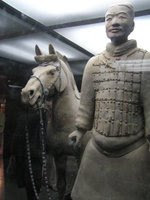Fairly coarse, porous clay that, when fired, assumes a color ranging from dull ochre to red. Terra-cotta objects are usually left unglazed and are often of a utilitarian kind, because of their cheapness, versatility, and durability. Small terra-cotta figures from 3000 BC have been found in Greece and others throughout the Roman Empire from the 4th century BC. The use of terra-cotta virtually died out when the Roman Empire collapsed, but it was revived in Italy and Germany in the 15th century.
Warrior:
A warrior is a person habitually engaged in warfare.
 Terracotta Army was buried with the Emperor of Qin (Qin Shi Huangdi) in 210-209 BC (his reign over Qin was from 247 BCto 221 BC and unified China from 221 BC to the end of his life in 210 BC). Their purpose was to help rule another empire with Shi Huangdi in the afterlife. Consequently, they are also sometimes referred to as "Qin's Armies".
Terracotta Army was buried with the Emperor of Qin (Qin Shi Huangdi) in 210-209 BC (his reign over Qin was from 247 BCto 221 BC and unified China from 221 BC to the end of his life in 210 BC). Their purpose was to help rule another empire with Shi Huangdi in the afterlife. Consequently, they are also sometimes referred to as "Qin's Armies".The Terracotta Army was discovered in March 1974 by local farmers drilling a water well to the east of Mount Lishan. (The precise coordinates are 34°23′5.71″N,109°16′23.19″ECoordinates: 34°23′5.71″N,109°16′23.19″E.) Mount Lishan is also where the material to make the terracotta warriors originated. In addition to the warriors, an entire man-made necropolis for the emperor has been excavated.

Terracotta Warriors Audio on BBC Learning English
Terracotta Warriors Script on BBC Learning English





1 comment:
ranks upon ranks of souvenir stands, subpar and terracotta army overpriced snack joints manned by aggressive terracotta warriors shills and wheedling vendors.
Post a Comment